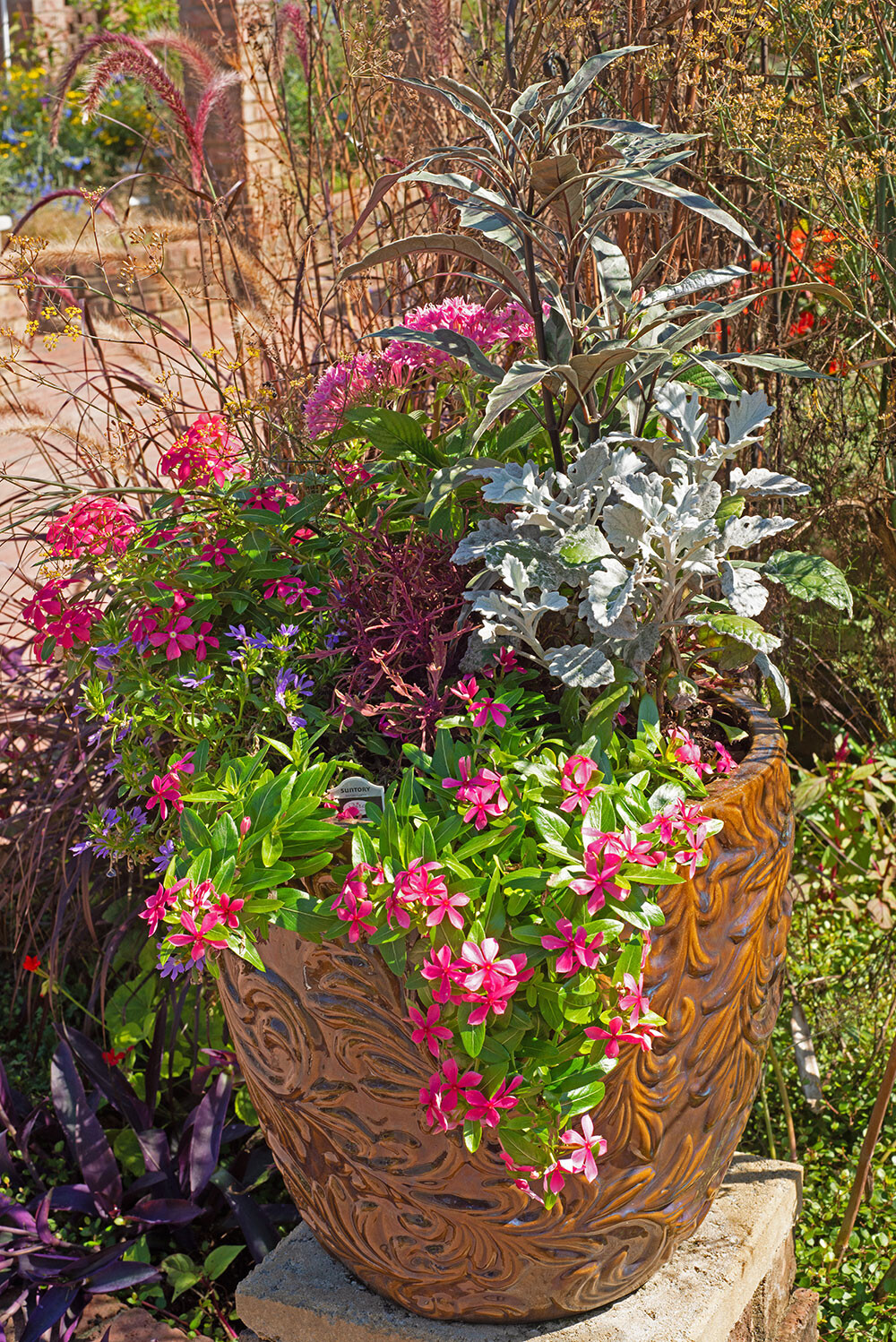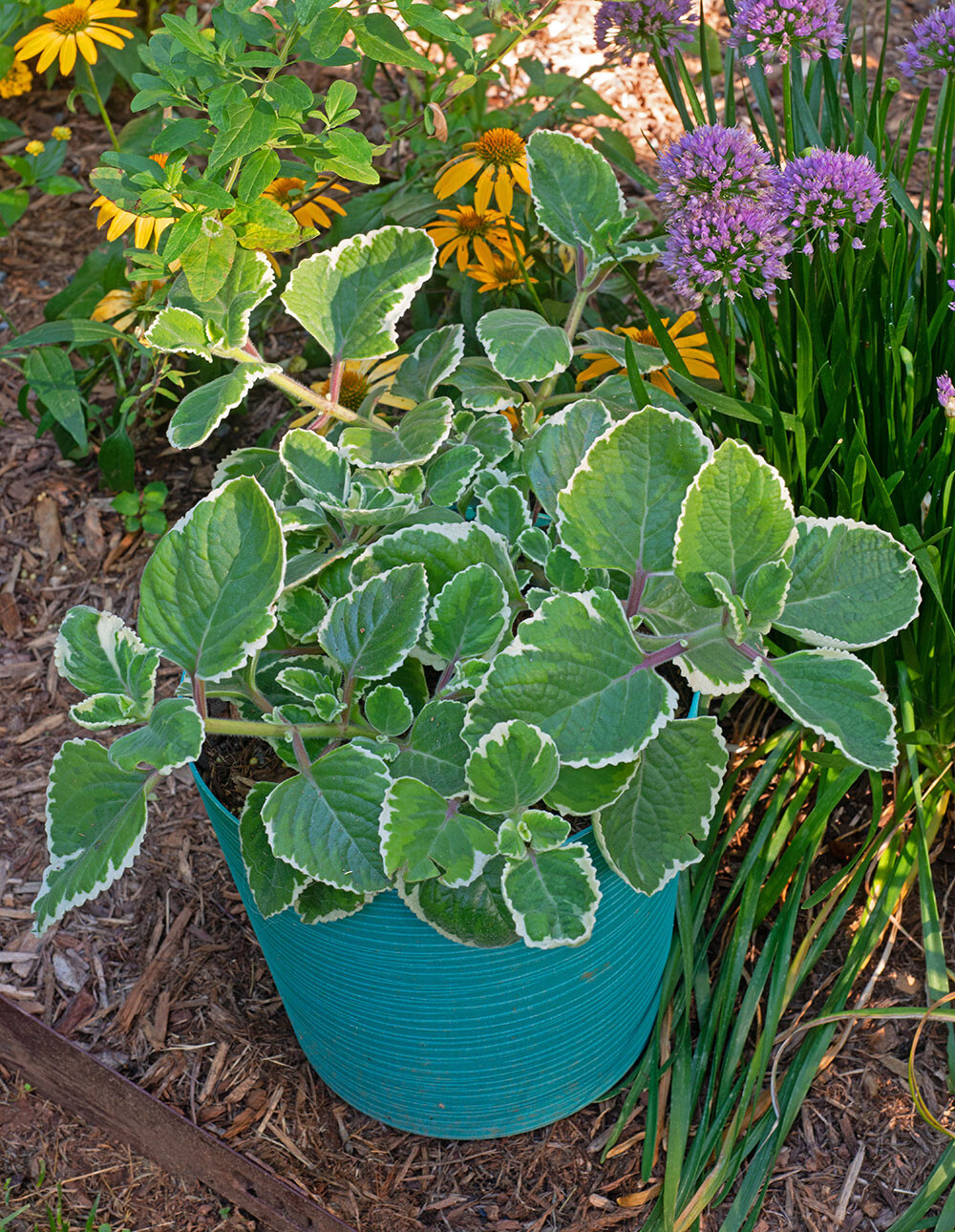Rarely have I grown a plant with so much geographical baggage as Cuban oregano (Plectranthus amboinicus). Why? Because it also goes by many other worldly names, such as French thyme, Indian borage, Mexican mint, Caribbean oregano, and Spanish thyme. Confused yet? And here’s the kicker: It originates from southern Africa!
So many names from so many places should give you a hint as to how popular this plant is, and rightly so. Cuban oregano (which isn’t related to true oregano) is an edible herb that can add extra zip to stews, steamed vegetables, marinades, soups, and salads. However, the flavor is strong, so it is typically used in moderation.
Like its flavor, Cuban oregano’s scent is also strong. Stroking the fuzzy, thick green leaves of the straight species will release a distinct oregano-like smell that has a hint of citrus with a dash of menthol.
There is a variegated form that, to me, smells less medicinal and more mouthwatering. Heck, every time I do a scratch-n-sniff, I crave pizza. Usually tagged either ‘Variegata’ or ‘Variegatus,’ this fancier Cuban oregano sports handsome green leaves with edges splashed in white to off-white coloration.
Because of its looks, variegated Cuban oregano is an eye-appealing option for ornamental gardens. Garden gurus say it will top out at about 15 to 20 inches, but that doesn’t always happen because this plant can be a flopper, especially in shady locations. Partially sunny sites make for stronger, more upright plants, and staking them up is certainly an option if they insist on drooping.
Cuban oregano can be garden grown in nutrient-rich and well-draining soil, but I plant it in pots for two reasons: (1) I don’t have to get down on all fours to sniff the aromatic leaves; and (2) it is a very tender perennial that won’t survive outside here in even mild winters.
But before freezing weather bites, I am already starting anew with Cuban oregano. In the fall, I take multiple cuttings from the existing plant and plunk them down in bottles of water.
New roots soon sprout from the clippings, and when they border on being full-blown fuzzy, each plantlet is set in a small container of quality potting soil in a sunny window. I spritz them occasionally with a spray bottle, keep the dirt moist but not soggy, and then wait for the new spring to enjoy even more of these scent-sational plants in the garden!

Trailing vinca can help keep roots cool in a container.
For better performances from planters and hanging baskets this summer, keep these tips in mind: (1) Unglazed clay pots leach moisture through their sides, meaning plants in them normally have to be watered more often; (2) the smaller the pot, the quicker it will dry out; (3) the more you irrigate, the more plant nutrients are washed away, so water with a diluted liquid fertilizer at least once a month through the growing season; and (4) trailing plants such as million bells, vinca, petunias, creeping Jenny, and ornamental sweet potatoes can shade pot sides to help keep root zones cooler.
To Do in the Garden
June
- If you enjoy starting summer flowers from seeds in the garden, soil temps are warm enough now to sow such pretties as sunflowers, zinnias, marigolds, cleome, gomphrena, blanket flowers, cosmos, nasturtiums, amaranth, and moonvine.
- Don’t think blossom end rot is just a tomato-centric disorder. Watermelons, squash, and peppers can come down with this ugliness, too. Since it is caused by stress related to wide fluctuations of soil temperature and moisture content, maintain at least a 3-inch mulch layer around these delectable edibles and keep them on a regular watering schedule.
July
- The herb garden should be maturing nicely now, but if plants such as savory, oregano, mint, thyme, or basil are starting to bully beyond their allotted space, cut them back. This early summer pruning will also help any lanky plants develop a bushier appearance.
- Continue filling the bird bath with water at least once or twice a week. To keep this fly-in refreshment stand clean, also give it a good wiping every two weeks. In addition, check the bird feeder after hard rains, and if any soggy yuck has accumulated in the basin, clean it out and refill with fresh, dry seed.
- Introducing Cary Magazine’s 2024 Movers & Shakers
- Notable Teens 2024
- Garden Adventurer: Cuban Oregano 101
- Liquid Assets: Lunch Break: Peanut Butter and Grape Jelly
- Liquid Assets: Where’s My Floatie
- Dampf Good BBQ
- Nonprofit Spotlight: Kids Together Playground
- Small Business Spotlight: Hunky Dory Record Shop
- E-Bike Adventures
- On Trend: Olympic Games, Home Edition
- Things to Do: June / July 2024








I have a big maple or oak? Tree. I can’t grow grass there. Also, a little away from the tree is a rounded cement curb. I would like to put a pretty ground cover in there when I dig up the dirt. Can you please give me several ground cover ideas. Would this Cuban oregano spoken about above be a good ground cover? Thanks so much!!